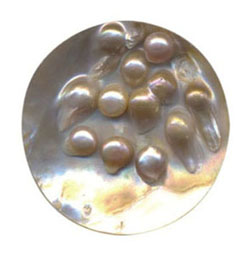 | BLISTER PEARLS | Hardness | - | | Color | - | | Origin | - | | Transparency | - | | |
|
| Cultured
pearls grow around a nucleus that
is manually inserted into an oyster or mussel. Modern techniques place the
nucleus within the soft body of the oyster, away from the shell, allowing it to
grow freely. Older techniques place the nucleus between the mantle and the
shell of the oyster, where the pearl develops as a "blister" attached
to the inner shell.
Blister
pearls are left attached to the
shell backing and the shell is polished to a smooth surface. Blister pearls are
often cut into lovely freeform shapes, showing both the inner shell and the
pearl. They can also be cut so that just the round pearl is left. These are in
essence "half-pearls" and are often used in earrings, rings, and pins
where a flat back is desirable.
Some people call blister pearls "mabe (ma-bay) pearls". This is only
accurate if the blister pearl was grown in a Mabe oyster.
The
Mabe oyster is a penquin wing oyster that produces blister pearls with better
luster, iridescence, and color than other species. Mabe Blister Pearls
have a rainbow spectrum of colors on their brilliant nacre, hence they are also
called Rainbow Pearls.
Mabe pearl is also used to refer to the process of creating a
half-pearl - even when the pearl was not grown in a Mabe oyster. These
half-pearls are manufactured by a specific method - the cultured blister pearl
is cut off the shell, the manually planted nucleus is extracted, the inside of
the nacre coating is painted, the void left by the nucleus is filled with an
epoxy, and the pearl is finished by covering the bottom with a polished piece
of mother-of-pearl.
|
|
|
|